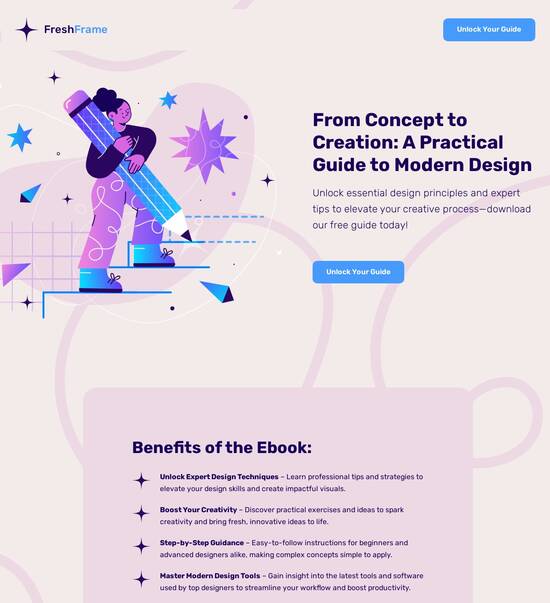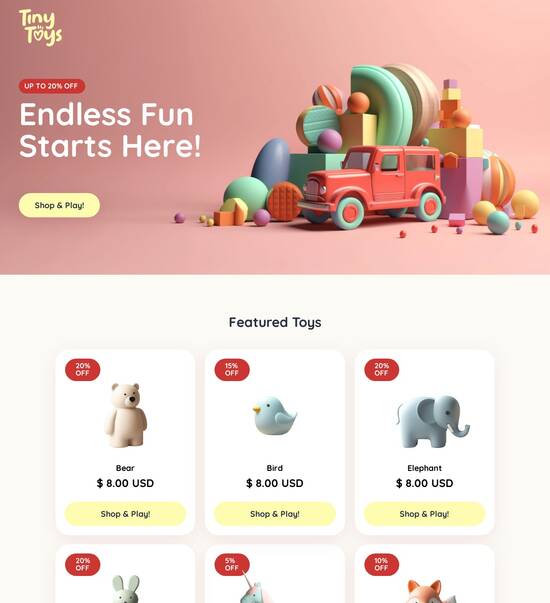
Next.js optimized trading page template
Explore Similar TemplatesAbout template
Supercharge your trading page with Next.js for outstanding performance! Learn more today.
Recommended templates

Easy to build without coding
With the intuitive drag-and-drop builder, anyone on your team can create high-converting pages without any knowledge of code or design. Make enhancements to your landing page with custom widgets using Javascript, HTML/CSS, or third-party scripts.

Multiple layouts for any industry and goal
Select from 500+ landing page layouts built to boost conversions across industry-specific scenarios. Customize them by adjusting fonts, adding images, and generating on-brand content with the AI assistant. Quickly scale with Instablocks® and Global Blocks that you can save, reuse, and update globally.

Loads fast and looks polished on any device
Every template is responsive, which means they present professionally on any device and load blazingly fast with our Thor Render Engine. You can also power them up with Google AMP technology to deliver an unparalleled mobile experience and drive higher conversions.

Robust analytics & experimentation
Get real-time updates and reporting across all your devices, showing the number of visitors, conversions, cost-per-visitor, and cost-per-lead. Launch AI-powered experiments, run A/B tests, and use heatmaps to analyze user behavior, then optimize your landing page to maximize conversions.







Easy to build without coding
With the intuitive drag-and-drop builder, anyone on your team can create high-converting pages without any knowledge of code or design. Make enhancements to your landing page with custom widgets using Javascript, HTML/CSS, or third-party scripts.
Multiple layouts for any industry and goal
Select from 500+ landing page layouts built to boost conversions across industry-specific scenarios. Customize them by adjusting fonts, adding images, and generating on-brand content with the AI assistant. Quickly scale with Instablocks® and Global Blocks that you can save, reuse, and update globally.
Loads fast and looks polished on any device
Every template is responsive, which means they present professionally on any device and load blazingly fast with our Thor Render Engine.
Robust analytics & experimentation
Get real-time updates and reporting across all your devices, showing the number of visitors, conversions, cost-per-visitor, and cost-per-lead. Launch AI-powered experiments, run A/B tests, and use heatmaps to analyze user behavior, then optimize your landing page to maximize conversions.
All the features you need to build lead-generating landing pages
Explore more featuresLearn how to build top-performing landing pages for any goal
FAQs
Leading the way in building high-performing landing pages





An effective landing page for marketers leveraging Instapage
Creating a landing page is essential for optimizing digital marketing campaigns. Instapage offers the most powerful landing page and conversion rate optimization (CRO) tools, enabling marketers to accelerate their strategies and maximize ROI. This guide provides a step-by-step approach to leverage Instapage for your landing page needs.
Understanding the importance of a dedicated landing page
Landing pages are crucial for directing user traffic to a singular goal. Unlike standard web pages, they focus on converting visitors into leads or customers by providing specific content and calls to action. A well-designed landing page can enhance your conversion rates significantly by engaging users effectively.
- Targeted Messaging: Tailor your message based on audience segmentation to resonate with specific groups.
- Clear Call-to-Action: Utilize compelling prompts to guide visitors on the next steps.
- Reducing Distractions: Limit navigation options to keep the visitor focused on the desired action.
Step 1: Choosing the right template
Instapage offers a library of 100+ high-converting templates to choose from, eliminating the need to start your design from scratch.
- Select a layout that Matches Your Brand: Choose a template that aligns visually with your brand identity.
- Incorporate Lead Gen Elements: Utilize pre-built forms within the template to automatically gather visitor information.
- Preview Responsiveness: Ensure the selected template is mobile-friendly, catering to a growing number of users accessing on mobile devices.
Step 2: Personalizing your content
Once you’ve selected your template, the next step is personalized content creation. It's vital to create high-performing landing pages tailored to different audiences.
- Dynamic Text Replacement: Use this feature to change content according to each visitor's unique characteristics.
- Utilize AdMaps: Align specific advertisements to distinct landing pages for better targeting.
- Segment-Based Metrics: Track individual audience engagement through Instapage's advanced data tools.
Step 3: Testing and optimizing your landing page
Optimization is a continuous process that involves testing various elements of your landing page. Instapage provides robust tools for experimentation.
- Conduct A/B Tests: Compare different versions of your landing page to determine which performs better.
- Analyze User Behavior: Use detailed heatmaps to see where users engage most on your page.
- Use Analytics Dashboard: Monitor performance metrics to understand your page's effectiveness and make data-driven decisions.
In conclusion, using Instapage to create and optimize your landing pages can significantly impact your marketing results. By following these steps, you can ensure that your pages convert visitors effectively.
Ready to boost your digital marketing efforts? Start creating high-converting landing pages today with Instapage by signing up for a free trial!
Next.js optimized trading page template: A guide for developers
Understanding Next.js: A revolutionary framework for trading page development
Next.js is a powerful React framework that enables developers to create high-quality web applications with ease. Its popularity is surging, especially in the FinTech industry, where real-time updates and performance are crucial. Built on top of React, Next.js optimizes web applications by providing features such as server-side rendering (SSR) and static site generation (SSG), ensuring dynamic data is presented efficiently. With an architecture designed for scalability, Next.js is perfectly suited for building trading platforms that require rapid data updates and user engagement.
Unpacking Next.js and its impact on trading applications
The essence of Next.js lies in its ability to combine the best of both static and dynamic rendering. For trading applications, this is particularly significant because they often need to deal with fluctuating market data. SSR allows pages to load data on the server side, meaning the user gets faster-loading pages, improving the overall user experience. Moreover, SSG can pre-render certain static pages, allowing for rapid access and minimal server load during peak trading times, transforming performance metrics.
Key features of Next.js that enhance trading applications include automatic code splitting, optimized loading, and built-in CSS and Sass support. Automatic code splitting ensures that users only download the necessary code for the page they are visiting, which further improves performance. The combination of these features creates a robust platform that meets the needs of modern trading applications.
The rise of trading page templates in FinTech
As the demand for trading platforms grows in the FinTech space, the need for templates that speed up development has become increasingly important. Trading platforms must integrate complex features like charting tools, real-time data feeds, and user management systems efficiently. Templates can provide an out-of-the-box solution that allows developers to focus on customization rather than starting from scratch. By utilizing Next.js templates, teams can enhance their workflows and deliver sophisticated applications faster, meeting market demands efficiently.
When comparing custom development with template-based solutions, it's clear that templates have a distinct advantage in terms of time and cost. Custom builds often require extensive planning and development cycles, whereas templates can be modified and deployed more rapidly. This ability to iterate quickly is essential in the highly competitive trading market where timing can lead to significant financial opportunities.
The anatomy of a Next.js optimized trading page template
Creating an efficient trading page template involves a deep understanding of user interface (UI) and user experience (UX) principles. Responsive design is particularly important; it ensures that users can access trading functionalities across various devices without compromising on experience. By incorporating tools like Material-UI or Ant Design, developers can create visually appealing and functionally effective interfaces that enhance user interactions.
Real-time data handling stands as a core requirement for trading platforms. Next.js's capabilities allow developers to seamlessly integrate live market data using WebSockets and APIs. This ensures that users receive timely updates and can make informed trading decisions. Furthermore, implementing performance optimization techniques such as Next.js routing for fast navigation and code splitting improves user engagement and satisfaction.
Key features of Next.js trading page templates
Next.js templates come equipped with various key features that transform trading platforms. One such feature is their SEO-friendly structure. Search engine optimization is crucial for attracting users; Next.js makes it easy to improve essential elements such as metadata, title tags, and URL structures. By enhancing these areas, trading platforms can rank higher in search results, driving more organic traffic.
SEO-Friendliness: Key for attracting and retaining users.
Internationalization (i18n) and RTL Support: Cater to diverse user bases.
Admin Dashboard Integration: Manage data and user interactions effectively.
The integration of internationalization (i18n) and right-to-left (RTL) support is vital for accessibility. Trading platforms catering to global audiences must implement multi-language support to enhance usability. Admin dashboard integration provides a comprehensive management solution for trading data, allowing for role-based access control and streamlined user management.
The development process: Building a trading page template with Next.js
When embarking on the development of a trading page template with Next.js, the first step is determining whether to choose the right template or start from scratch. Factors such as required features, complexity, and budget should be considered when selecting a suitable template from the community or building a new one. Evaluating community-built templates against custom solutions can often yield a valuable list of options that speed up development.
Setting up a Next.js environment is straightforward. Developers need to begin by installing Node.js and then initiating a Next.js app using commands like 'npx create-next-app'. Essential npm packages and dependencies can subsequently be added based on the specific needs of the trading application. Following setup, adopting best practices such as version control and collaborative development tools ensures smooth workflows.
Benefits of utilizing Next.js trading page templates
Utilizing Next.js trading page templates offers substantial benefits, primarily focusing on rapid development and deployment. Time savings can be significant; teams are able to deploy comprehensive applications much faster using pre-designed templates while retaining customization flexibility. Examples of successful platforms deploying these solutions reflect significant time efficiencies that are vital in the fast-paced trading world.
Enhanced user engagement and retention are additional benefits from optimized trading pages. By improving overall user experience through faster loading times and relevant functionalities, platforms can see increased interaction rates. On the financial side, templates provide a cost-effective alternative to traditional bespoke solutions, allowing companies to allocate resources strategically toward growing and scaling their platforms.
Customization and extensibility of Next.js templates
Next.js templates offer robust customization and extensibility options catering to various business needs. Developers can tailor layouts, components, and styles without compromising on performance. Implementing additional features tailored to specific trading requirements can significantly enhance the value offered to users. The flexibility of Next.js ensures that developers can iterate on design and functionality to meet shifting market demands.
Integration with third-party services further exemplifies the extensibility of Next.js applications. This could range from payment gateways to trading APIs and analytical tools. Best practices involve managing dependencies effectively to maintain robust performance while ensuring seamless connectivity with external services. This results in a comprehensive trading platform that meets the high standards expected in today's financial landscape.
Documentation and community support
Next.js is backed by extensive official documentation, providing developers with resources to navigate its capabilities with ease. This documentation serves as a valuable tool for both new and experienced developers looking to enhance their applications. Engaging with the Next.js developer community, through forums, GitHub discussions, and local meetups, also fosters collaboration and sharing of innovative practices and solutions.
Moreover, community-driven plugins and tools can enhance the functionality of Next.js applications. By leveraging these resources, developers can access a wealth of additional capabilities and solutions built by peers, enriching their own projects. This collaboration creates a supportive ecosystem that continuously evolves and improves.
Real-world success stories: Next.js in action
There are numerous case studies highlighting trading platforms that have successfully utilized Next.js templates. These implementations reveal significant performance improvements and increased user engagement metrics. By employing optimized solutions, companies have reported faster load times and a marked rise in user interactions, showcasing the tangible benefits of adopting Next.js.
Testimonials from developers and users further validate the effectiveness of Next.js. They speak to the framework's ease of use, flexibility, and the ability to adapt to ever-changing market conditions, providing a solid foundation for building successful trading platforms.
Future trends in trading page development
As technology evolves, so does the landscape of trading platforms. Predictions suggest a greater reliance on AI and machine learning, creating opportunities for more personalized user experiences. Next.js is expected to play a key role in this evolution, as its capabilities align well with new technological advancements in financial technology. Its framework is likely to adapt and grow in response to the needs of users.
The focus on improving trading experiences opens the door for innovations that prioritize user satisfaction and engagement. Platforms will evolve to incorporate features that enhance the decision-making process, ensuring users receive relevant information when they need it. Next.js will undoubtedly remain a contender in shaping the future of trading page development.
Conclusion: Embracing Next.js for cutting-edge trading solutions
In summary, Next.js stands out as a transformative solution for developing trading applications. Its powerful features, flexible templates, and strong community support position it at the forefront of the FinTech industry's evolution. Developers and businesses alike should explore the multitude of Next.js templates available, tailoring them to meet their unique requirements.
As the trading landscape continues to change, utilizing modern frameworks like Next.js becomes essential. It allows developers to meet customer expectations more effectively, providing a solid foundation for building high-performing platforms. The future of trading page development is undoubtedly bright with Next.js paving the way.
Ready to skyrocket conversions?
Supercharge your ad campaigns with high-performing landing pages
Get started














